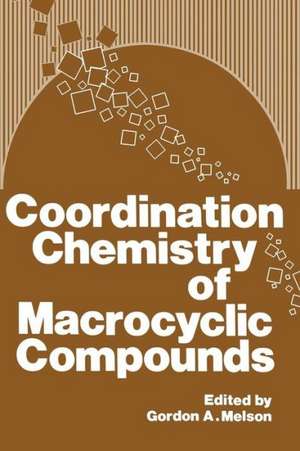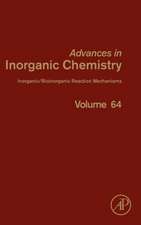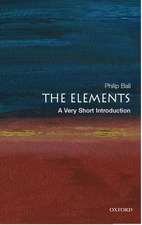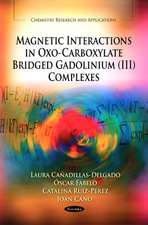Coordination Chemistry of Macrocyclic Compounds
Editat de Gordon Melsonen Limba Engleză Paperback – 12 oct 2011
Preț: 659.02 lei
Preț vechi: 775.32 lei
-15% Nou
Puncte Express: 989
Preț estimativ în valută:
126.10€ • 131.40$ • 104.41£
126.10€ • 131.40$ • 104.41£
Carte tipărită la comandă
Livrare economică 04-18 aprilie
Preluare comenzi: 021 569.72.76
Specificații
ISBN-13: 9781461329305
ISBN-10: 1461329302
Pagini: 680
Ilustrații: XIV, 664 p.
Dimensiuni: 155 x 235 x 36 mm
Greutate: 0.93 kg
Ediția:Softcover reprint of the original 1st ed. 1979
Editura: Springer Us
Colecția Springer
Locul publicării:New York, NY, United States
ISBN-10: 1461329302
Pagini: 680
Ilustrații: XIV, 664 p.
Dimensiuni: 155 x 235 x 36 mm
Greutate: 0.93 kg
Ediția:Softcover reprint of the original 1st ed. 1979
Editura: Springer Us
Colecția Springer
Locul publicării:New York, NY, United States
Public țintă
ResearchCuprins
1. General Introduction.- 1. Introductory Comments.- 2. General Comments.- References.- 2. Synthesis of Macrocyclic Complexes.- 1. Introduction.- 2. Tridentate Ligands.- 3. Tetradentate Ligands.- 4. Pentadentate Ligands.- 5. Sexadentate Ligands.- 6. Binucleating Ligands.- 7. Clathrochelates.- 8. Conclusions.- References.- 3. Thermodynamics and Kinetics of Cation-Macrocycle Interaction.- 1. Introduction.- 2. Parameters Determining Cation Selectivity and Complex Stability.- 3. Macrocyclic Effect.- 4. Table of Thermodynamic Data.- 5. Kinetics.- References.- 4. Structural Aspects.- 1. Introduction.- 2. Class 1: Cyclic Amines-Saturated Polyaza Macrocycles.- 3. Class 2: Cyclic Imines and Cyclic Amine-Imines (Unsaturated Polyaza Macrocycles with all Nitrogen Atoms Coordinated).- 4. Class 3: Macrocycles Including a 2,6-Pyridyl Group.- 5. Class 4: Tetraazamacrocycles with 2-Imino(or 2-amido)-benzaldimine Chelate Rings.- 6. Class 5: Dibenzo[b,i]-l,4,8,11-tetraazacyclotetradec-2,4,6,9,11-hexaenato(2–) Compounds.- 7. Class 6: Cyclic Hydrazines and Hydrazones.- 8. Class 7: Cyclic Tetraethers and Tetrathiaethers (Tetraoxo- and Tetrathiamacrocycles).- 9. Class 8: Macrocycles with More Than One Type of Heteroatom.- 10. Class 9: Binucleating Macrocycles.- 11. Class 10: Cyclic Phosphazenes.- 12. Class 11: Clathrochelates.- 13. Conclusion.- References.- 5. Ligand Field Spectra and Magnetic Properties of Synthetic Macrocyclic Complexes.- 1. Introduction.- 2. Nickel Complexes.- 3. Copper Complexes.- 4. Cobalt Complexes.- 5. Iron Complexes.- 6. Manganese Complexes.- References.- 6. Chemical Reactivity in Constrained Systems.- 1. Introduction.- 2. Predominantly Metal-Centered Reactions.- 3. Reactions of the Macrocyclic Ligands.- 4. Reactions Involving Free Radicals, Unusual OxidationStates, and Excited States.- References.- 7. Metal Complexes of Phthalocyanines.- 1. Introduction.- 2. Molecular Structure.- 3. Electronic Structure.- 4. Spectral Properties.- 5. Synthesis of New Derivatives.- 6. Redox Reactions.- 7. Aggregation of Complexes.- 8. Chromium Complexes.- 9. Manganese Complexes.- 10. Iron Complexes.- 11. Cobalt Complexes.- 12. Group IV Metal Complexes.- 13. Catalytic Activity.- 14. Comparison of Chemistry of Chromium, Manganese, Iron, and Cobalt Complexes.- References.- 8. Coordination Chemistry of Porphyrins.- 1. Introduction.- 2. Synthesis.- 3. Structure.- 4. Reactions.- 5. Chlorins and Corrins.- References.- 9. Physicochemical Studies of Crown and Cryptate Complexes.- 1. Introduction.- 2. Synthetic Methods.- 3. Metal-Cation Complexes: Preparation and Structure.- 4. Complexes in Solutions: Experimental Techniques.- 5. Conclusion.- References.- 10. Natural-Product Model Systems.- 1. Introduction.- 2. Macrocyclic Complexes as Models.- 3. Modeling of Heme Proteins.- 4. Binuclear Systems.- 5. Comments on Vitamin B12 and Related Inorganic Systems.- References.









